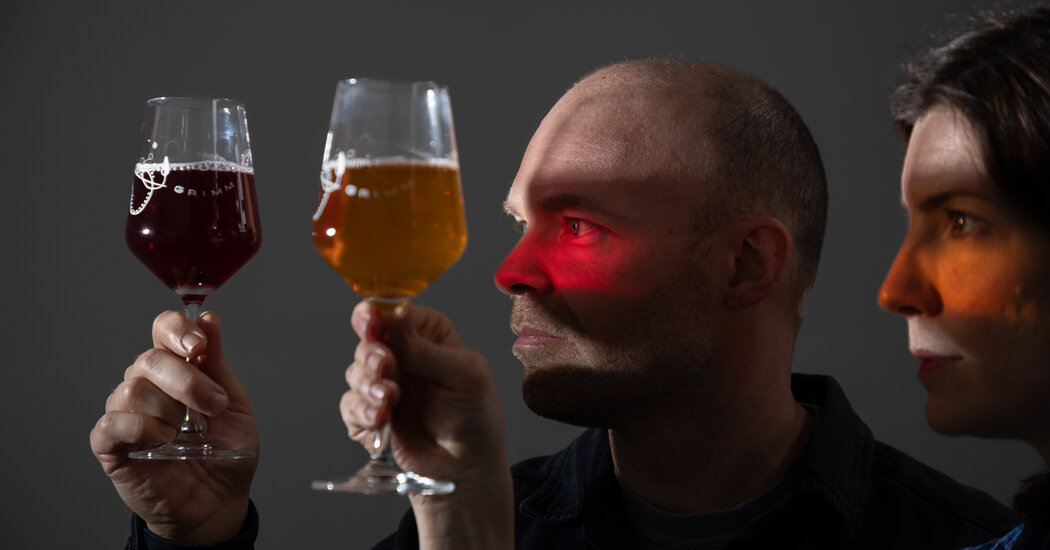One could easily mistake Alesong Brewing & Blending for a winery. The brewery, which opened in 2016 in Eugene, Ore., makes beer-wine hybrids with local grapes and sells barrel-aged beer through a membership club.
“If you take the word beer out of our business model, we look a lot more like a winery,” said Brian Coombs, a founder and production manager at Alesong, who previously worked at the nearby King Estate Winery, in the Willamette Valley wine region. Last September, Alesong introduced its first wine, a pinot gris, in an effort to broaden the brewery’s creative ambitions and customer base.
“It’s great when you have people that come in and are like, ‘Oh, no, we only drink wine,’ or they have a gluten intolerance,” said Mr. Coombs, who plans to buck winemaking conventions by, say, adding cherries or coconut to a pinot noir. “I want to look at wine from a brewer’s perspective.”
Craft breweries have boomed over the last 15 years by breaking flavorful new ground, no rule too sacred. Now they’re applying that ethos to winemaking, swapping grains for grapes and other fruits to meet the diverse needs of customers who treat taprooms as bars.
The learning curve for making wine can be steep and slow to climb. Breweries can make and refine batches of beer every few weeks, steadily adjusting hops, grains, yeast strains and production techniques. But winemakers produce only one vintage annually: A bad harvest or improper fermentation can impact quality, leaving winemakers with less margin for error and fewer opportunities for on-the-fly refinement.
Pete Ternes, an owner of Middle Brow Beer & Wine Company, in Chicago, made trial batches of wine soon after opening a pizza-focused brew pub in 2019. The wine “tasted like nail-polish remover,” Mr. Ternes said.
Over time he refined his techniques and ingredients, driving to Michigan to pick grapes that were later stomped outside the brew pub. One blend of Michigan grapes, accidentally fermented at higher pressure, led to Middle Brow’s fizzy, Lambrusco-like Pizza Wine.
“We’re approaching it like scrappy craft brewers,” said Mr. Ternes, who started serving the brewery’s wines in 2023.
For businesses like Allagash Brewing in Portland, Maine, getting into winemaking allowed the company to circumvent a clause in its state liquor license that prohibited the brewery from selling alcoholic beverages from other producers in its taproom.
After securing a winery license in 2021, Allagash began offering fruit wines made with locally grown honeyberries and blueberries. Winemaking opens a new avenue for creative exploration. “I’m excited about utilizing fruit from Maine” that’s not typically fermented into wine, said Patrick Chavanelle, the senior research and development brewer.
In 2020, Josh Elliott, a former head brewer at Urban Artifact in Cincinnati, left beer altogether to create Fruitblood, a line of sparkling wines made from peaches, boysenberries and cherries. He produces his wines at Urban Artifact, which invested in Fruitblood and had space to house and support a winery, using some of the brewery’s equipment and sharing shipments of high-quality fruit.
The switch to winemaking is even more natural for brewers who are already fermenting fruit. Joe and Lauren Grimm, the couple who own Grimm Artisanal Ales in Williamsburg, Brooklyn, embraced the winemaking technique of carbonic maceration to make their fruited sour ales.
“We were like, ‘Oh, we’re making fruit wine. Why don’t we make this with grapes, too?’” Ms. Grimm said.
Last year, the couple released the first vintages of Physica Wines, a sister winery that uses grapes grown on Long Island to make low-intervention wines fermented in stainless steel cubes. The Grimms then steep sour ales with spent grape skins, creating a circular production process in which nothing is wasted. “Our wines all have an associated beer,” Ms. Grimm said.
Persuading people to take wine made in a brewery seriously can be difficult, because it may seem like “this little pet project,” said Tim Gormley, the director of Visuals Wine, the winemaking arm of Burial Beer Company. in Asheville, N.C. To showcase its commitment to winemaking, the brewery next month will open a rooftop wine bar. “I really want to lean into flights,” Mr. Gormley said.
Before becoming head winemaker and farm manager for the cult winery Screaming Eagle in Oakville, Calif., Nick Gislason brewed beer professionally. Now he draws on his experiences in both worlds with Hanabi Lager Company, which he opened in 2020 with his wife, Jennifer Angelosante.
Inside a friend’s winery in Napa, Calif., Mr. Gislason builds lagers around single varieties of heirloom malt, just as a winery would do with a specific grape varietal such as chardonnay or riesling. Time is also an essential ingredient: The lagers from Hanabi are fermented for upward of five months, a long time for lagers, to draw out nuanced aromas and flavors that might evoke peppermint or candied orange peel. The meticulous approach to lager fermentation inspired Mr. Gislason to approach fermenting his wine with more precision, adjusting temperatures and oxygen exposure to create clean and expressive wines.
“My way of thinking about beer is informed by winemaking,” he said. “Being a brewer makes me a better winemaker, and being a winemaker makes me a better brewer.”







